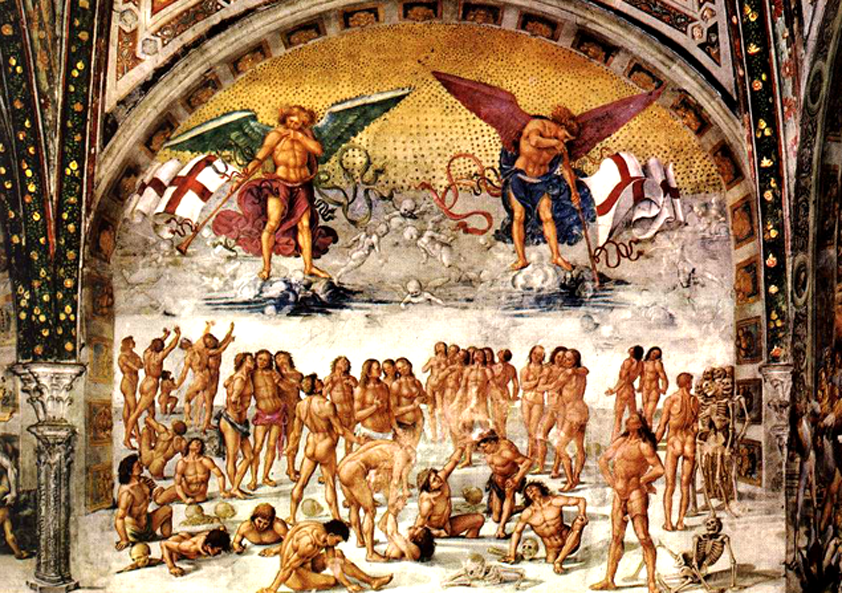At Luca Signorelli’s Resurrection of the Body
See how they hurry to enter
their bodies,
these spirits.
Is it better, flesh,
that they
should hurry so?
From above
the green-winged angels
blare down
trumpets and light. But
they don’t care,
they hurry to congregate,
they hurry
into speech, until
it’s a marketplace,
it is humanity. But still
we wonder
in the chancel
of the dark cathedral,
is it better, back?
The artist
has tried to make it so: each tendon
they press
to re-enter
is perfect. But is it
perfection
they’re after,
pulling themselves up
through the soil
into the weightedness, the color,
into the eye
of the painter? Outside
it is 1500,
all round the cathedral
streets hurry to open
through the wild
silver grasses...
The men and women
on the cathedral wall
do not know how,
having come this far,
to stop their
hurrying. They amble off
in groups, in couples. Soon
some are clothed, there is
distance, there is
perspective. Standing below them
in the church
in Orvieto, how can we
tell them
to be stern and brazen
and slow,
that there is no
entrance,
only entering. They keep on
arriving,
wanting names,
wanting
happiness. In his studio
Luca Signorelli
in the name of God
and Science
and the believable
broke into the body
studying arrival.
But the wall
of the flesh
opens endlessly,
its vanishing point so deep
and receding
we have yet to find it,
to have it
stop us. So he cut
deeper,
graduating slowly
from the symbolic
to the beautiful. How far
is true?
When his one son
died violently,
he had the body brought to him
and laid it
on the drawing-table,
and stood
at a certain distance
awaiting the best
possible light, the best depth
of day,
then with beauty and care
and technique
and judgment, cut into
shadow, cut
into bone and sinew and every
pocket
in which the cold light
pooled.
It took him days,
that deep
caress, cutting,
unfastening,
until his mind
could climb into
the open flesh and
mend itself.
to enter
their bodies,
these spirits.
Is it better, flesh,
that they
should hurry so?
From above
the green-winged angels
blare down
trumpets and light. But
they don’t care,
they hurry to congregate,
they hurry
into speech, until
it’s a marketplace,
it is humanity. But still
we wonder
in the chancel
of the dark cathedral,
is it better, back?
The artist
has tried to make it so: each tendon
they press
to re-enter
is perfect. But is it
perfection
they’re after,
pulling themselves up
through the soil
into the weightedness, the color,
into the eye
of the painter? Outside
it is 1500,
all round the cathedral
streets hurry to open
through the wild
silver grasses...
The men and women
on the cathedral wall
do not know how,
having come this far,
to stop their
hurrying. They amble off
in groups, in couples. Soon
some are clothed, there is
distance, there is
perspective. Standing below them
in the church
in Orvieto, how can we
tell them
to be stern and brazen
and slow,
that there is no
entrance,
only entering. They keep on
arriving,
wanting names,
wanting
happiness. In his studio
Luca Signorelli
in the name of God
and Science
and the believable
broke into the body
studying arrival.
But the wall
of the flesh
opens endlessly,
its vanishing point so deep
and receding
we have yet to find it,
to have it
stop us. So he cut
deeper,
graduating slowly
from the symbolic
to the beautiful. How far
is true?
When his one son
died violently,
he had the body brought to him
and laid it
on the drawing-table,
and stood
at a certain distance
awaiting the best
possible light, the best depth
of day,
then with beauty and care
and technique
and judgment, cut into
shadow, cut
into bone and sinew and every
pocket
in which the cold light
pooled.
It took him days,
that deep
caress, cutting,
unfastening,
until his mind
could climb into
the open flesh and
mend itself.